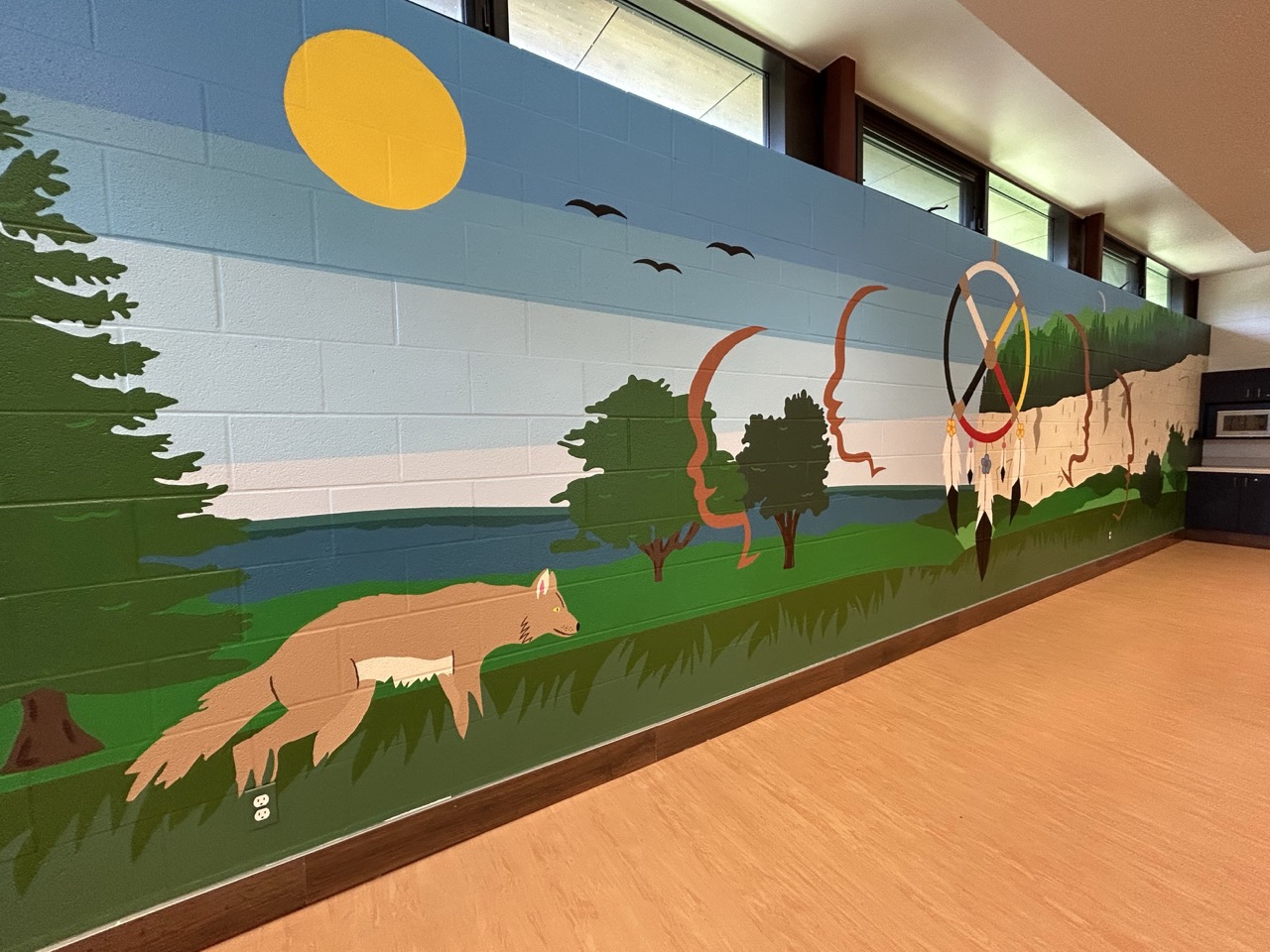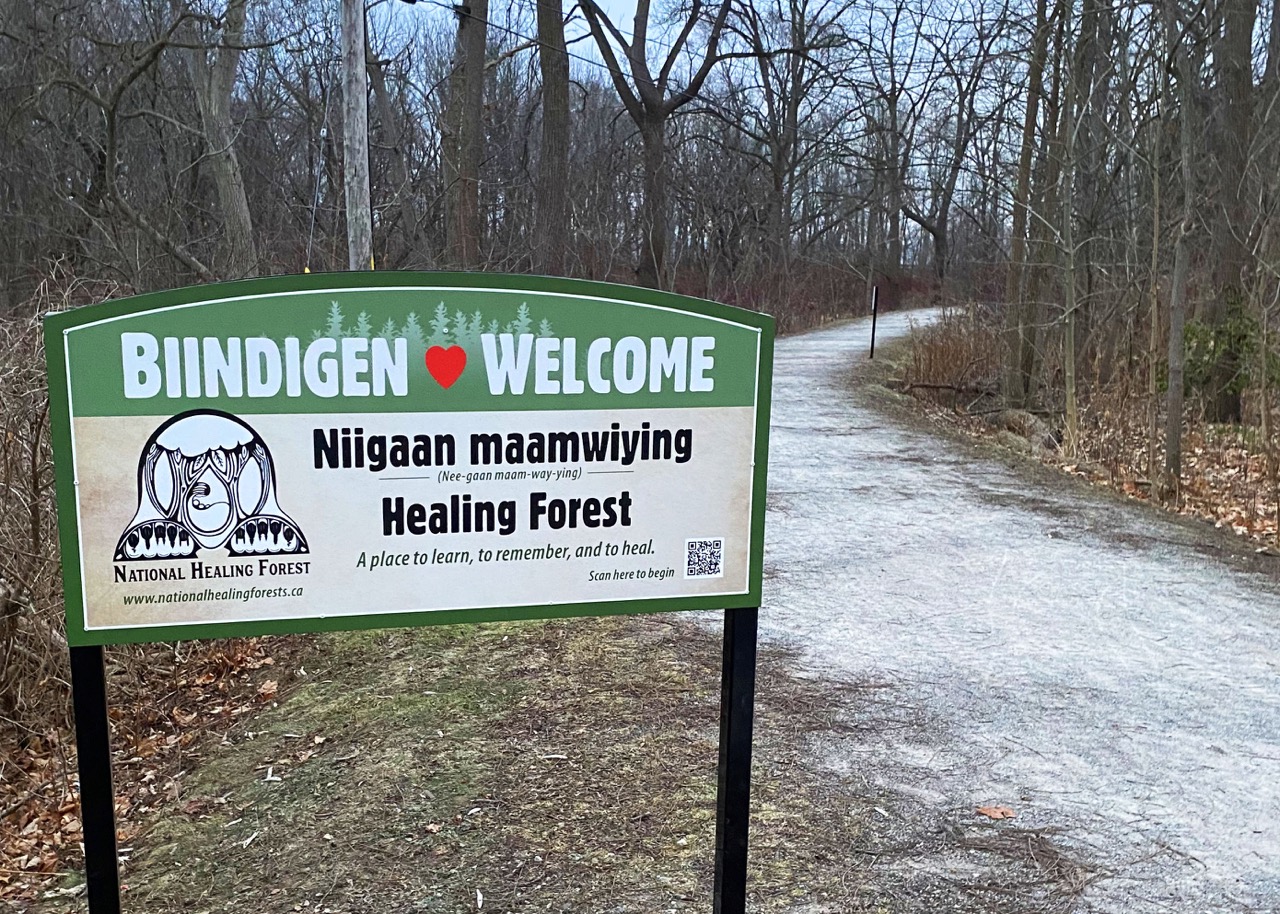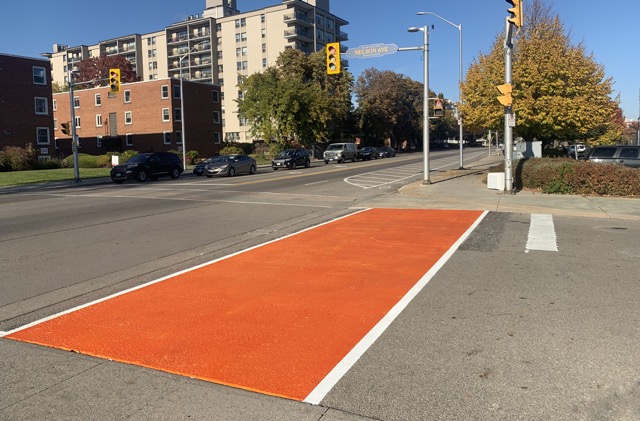Indigenous Projects and Partnerships in Burlington
Indigenous people have a respected and important history across North America leaving what is often referred to as a ‘moccasin trail’. Many Indigenous groups have crossed the area including what is now the City of Burlington (treaty lands and territory of Mississaugas of the Credit First Nation) by land and by the many waterways.
Burlington’s City Council, staff and volunteers collaborate with Indigenous leaders and community members to implement projects and initiatives that create awareness of First Nations history and break down barriers of misinformation, arriving at the Truth followed by Reconciliation.
City of Burlington recognizes we are on treaty lands and territory of Mississaugas of the Credit First Nation members. As recognition, the City permanently flies the Mississaugas of the Credit flag at City Hall and at Port Nelson Park, and reads the Land Acknowledgement at the beginning of Council and formal community meetings.
Follow this page to learn more about the City of Burlington’s projects that honour Indigenous culture and community. Projects will be added to this page as they are finalized. Questions or requests for more information about the various initiatives can be directed to indigenousspaces@burlington.ca.
Indigenous Advisory Circle to the Mayor
In November 2022, Burlington Mayor Marianne Meed Ward announced the formation of the Indigenous Advisory Circle as part of the City’s commitment to advancing Reconciliation, beginning with the principle of Reconciliation as Relationship.
The Advisory Circle to the Mayor brings together urban Indigenous residents living in Burlington to share their lived experiences, offer guidance to the Mayor and staff, and identify opportunities for the City to take tangible actions toward Reconciliation.
The Circle also provides recommendations on how the City can enact the five municipal Calls to Action identified by the Truth and Reconciliation Commission (TRC): Calls to Action 43, 47, 57, 75 and 77.

Sweetgrass Park
Sweetgrass Park celebrates Indigenous culture, teachings and enhances community access to nature and learning.
The park, developed in close consultation with the Indigenous Advisory Circle to the Mayor, features a ceremonial circle designed for full moon and other traditional ceremonies as well as a contemplative area near Tuck Creek. Full moon ceremonies are anticipated to begin taking place at Sweetgrass Park this fall.
Both the ceremonial areas include stone seating known as “wisdom” stones, sweetgrass and Cedar tree plantings, surrounded by pollinator perennials. These cultural items reflect the City’s commitment to honouring Indigenous traditions to be celebrated by all who come to the park.
Two special custom benches are installed in the park to support the Moccasin Identifier Project, founded by Carolyn King in partnership with the Mississaugas of the Credit First Nation and the Greenbelt Foundation.
Moccasin Identifier is an Indigenous-led initiative dedicated to increasing awareness and understanding of Indigenous treaties and history across Canada. Their mission is to cover Canada in moccasins, creating visual and educational reminders of the significance of Treaties and the Indigenous relationship to the land.
The City of Burlington is grateful for an anonymous donation which funded a large part of this project.
This is a sacred Indigenous site and therefore can only be booked by Halton Region Indigenous community members. For more information and/or booking inquiries, please email indigenousspaces@burlington.ca.

Mountainside Community Room and Mural
The Mountainside community room is a priority space for Indigenous events, ceremonies and meetings in Community Room 2 at Mountainside Community Centre. The community room, created in collaboration with the Indigenous Advisory Circle to the Mayor, features a mural called Our Voices Carry the Land by Indigenous artist Tessa-Lynne Chartrand. The mural is a celebration of connection, community and inclusivity, rooted in Indigenous ways of knowing.
Community Room 2 is a space that centres around Indigenous culture, learning, and community. It serves as a priority venue for Indigenous ceremonies, gatherings, teachings, and outreach—free of charge for Halton Indigenous community members. While this focus guides the room’s purpose, the space is open for bookings and programming by everyone.
For more information and booking inquiries, please contact indigenousspaces@burlington.ca.

The Healing Forest
Healing Forests promote community and relationship between Indigenous and non-Indigenous peoples. Included is a self-guided medicine walk, which highlights the many species living within the forest informed by Traditional Ecological Knowledge. The Mississaugas of the Credit First Nation have provided support and guidance throughout the creation of the Healing Forest.
The Healing Forest will provide Burlington citizens with the type of care that only a forest can provide. It has been established through the collaboration of Indigenous and non-Indigenous professionals working together in the spirit of reconciliation to develop a unique space for healing, community, and connection to nature.

Orange Crosswalk
The orange crosswalk is in honour of the children of the residential school system.
The crosswalk acknowledges the strength and survival of residential school survivors, and honours the victims, their families, and communities.

National Indigenous Peoples Day
National Indigenous Peoples Day, celebrated each year on June 21, is a day to recognize and honour the cultures, histories, and contributions of First Nations, Inuit, and Métis peoples across Canada. Coinciding with the summer solstice—a day that holds spiritual significance for many Indigenous communities—this day provides an opportunity for all Canadians to learn about and celebrate the rich diversity of Indigenous traditions, languages, and achievements.
An event planned in collaboration with the Indigenous Advisory Circle to the Mayor, is typically held each year at Spencer Smith Park. All are welcome to attend.
Information about the event will be shared on social media and posted on the events calendar.

Orange Shirt Day
Orange Shirt Day (also known as National Day of Truth and Reconciliation) is held each year on Sept. 30, as a day of remembrance and education that honours the survivors of residential schools, their families, and the children who never returned home. Orange Shirt Day serves as a powerful reminder that “Every Child Matters”, encouraging reflection on the legacy of residential schools and promoting reconciliation through awareness, dialogue, and action.
A reflective gathering planned in collaboration with the Indigenous community members is typically held each year at Spencer Smith Park. All are welcome to attend.
This is a day off for municipal employees as part of a direct response to TRC’s Call to Action #80. This is done so that employees have the time to reflect on the truth of our history and the path forward toward reconciliation.
Information about the event will be shared on social media and posted on the events calendar.
Full Moon Ceremonies
Indigenous full moon ceremonies are sacred gatherings honouring Grandmother Moon and are led by women. Based on the lunar calendar, they provide a time for women to reconnect with themselves and strengthen their ties to others and the natural world through healing and renewal. The ceremony occurs at or near sunset, with a reflection on the past month, and setting intentions for the next cycle.
These ceremonies take place at Sweetgrass Park and Sioux Lookout Park.
Indigenous Public Art
The City of Burlington is committed to celebrating Indigenous artists through our public art program. This includes Bimose Agaming | Walking along the Lake, an art walk featuring the work of First Nations, Métis and Inuit artists in Spencer Smith Park, Conversations and Stories, a large-scale sculpture by David General at Joseph Brant Museum and the mural Our Voices Carry the Land by Tessa Lynne Chartrand at Mountainside Community Centre.
Along the Water, Across the Land
This public art story map highlights and celebrates the creativity of Indigenous artists from across Turtle Island. Through installations across the city, these artworks embody stories of identity, connection, resilience, and cultural continuity. Along the Water, Across the Land features contributions from First Nations, Inuit, and Métis artists whose artwork reflects diverse Indigenous perspectives and traditions. Each piece offers insight into the artists lived experiences and communities, while honouring Indigenous ways of knowing, language, land, and storytelling.

